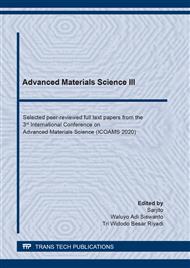p.137
p.147
p.153
p.159
p.167
p.175
p.181
p.189
p.197
The Effect of Water Content on Particle Characterization of Bamboo Charcoal Resulted from Ball Milling
Abstract:
The objective of this research is to study the effect of water content on particle characterization and agglomeration of bamboo charcoal resulted from ball milling process. The characterization is determined by the particle size and the morphology of the particle. The milling was performed in cylinder vial of stainless steel. The element of milling is steel balls. The dimension of the cylinder vial was 120 mm length and 1-inch diameter, while the ball diameter was 5/32 inch. The charcoal resulted from pyrolysis was milled manually then strained with a filter size of 200 meshes. The particles passing the strainer were washed in water and then dried to obtain 25%, 28%, 32% and 35% water content. Then they were put together with the milling balls into cylinder vial. There were four vials with a water content of 25%, 28%, 32% and 35% respectively for milling process. Every vial contained 11 grams of bamboo charcoal and approximately 299 grams of steel balls. It represents 1/3 of vial volume for charcoal, 1/3 of vial volume for ball and 1/3 of vial volume for empty space. Two type tests were conducted. The first test was to run the milling machine at 700 rpm for 2 million cycles and the second test was to run the milling machine at 1000 rpm for 3 million cycles. Particulate characterization was done by a particle size analyzer (PSA), a scanning electron microscope (SEM) with energy dispersive X-Ray (EDX). The results showed that the water content does not have any influenced to the particle size. For the both test the particle sizes are in the range of 100 nm or less to more than 1 μm. However, the second test produces smaller particles and a higher number of smaller particles due to higher impact energy and longer milling time. The two tests inform that agglomeration does not happen by having wet milling. The dominant element of the bamboo charcoal is carbon with more than 90% in number.
Info:
Periodical:
Pages:
189-196
Citation:
Online since:
May 2021
Keywords:
Price:
Сopyright:
© 2021 Trans Tech Publications Ltd. All Rights Reserved
Share:
Citation:


